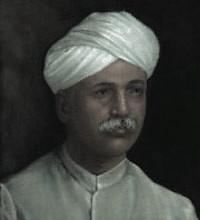A paper titled "The Perspective of Practical Vedanta in the Works of M. Hiriyanna" was presented by Arjun Bharadwaj at the international conference "New Frontiers in Sanskrit and Indic Knowledge" (NFSI) on 12th June 2017 organized by the Chinmaya Vishwavidyapeeth. The current article contains excerpts from the paper.
Introduction: The Vedānta School of Philosophy
Indian philosophy originated under the presence of a practical need arising from the presence of moral and physical evil in life. The ancient Indian’s interest in solving puzzles of knowledge was chiefly to find out a remedy, if possible, for the ills of life. All schools of Indian philosophy have for their ideal the concept of mokṣa, although the definition varies from one school to the other. The philosophy of the Upaniṣads as retold by Śaṅkara in his advaita doctrine however, removes the mystical and other-worldly character of mokṣa and has jīvanmukti - ‘deliverance during life’ for its goal. It brings the ideal of mokṣa within the sphere of practical experience [1], [2]. Hiriyanna observes that mokṣa as defined in the advaita doctrine can be justly regarded as the point of union of philosophy and religion. It is this school of philosophy that will be referred to as ‘Vedānta’ throughout this article.
Why is Mokṣa the Ideal?
It is common experience that all human beings consciously try to be happy and attempt to maximize the duration of their happiness. All our actions in day-to-day living are directed towards being happy. No one consciously wishes to be unhappy. Besides, man has the capacity for self-criticism, which points to an awareness of a standard by which he judges, and this standard can be nothing short of absolute perfection, for the simple reason that the need for criticism will continue to be felt until an ideal, which is free from all imperfections and is therefore completely satisfying, is reached [3]. The existence of this ideal urges him to strive towards reaching a state in which he may rest with a feeling of contentment. Moreover, imperfections are functions of space and time. It is the presence within him of this ideal of perfection that makes man a spiritual being. The craving for perfection and peaceful contentment is common to all humans. The quest after this perfect ideal is the process of Vedānta and the ideal is mokṣa. The ideal is a conscious experience of the perfect Bliss, jñānānanda, that transcends space and time and that is the very nature of the Absolute Entity, the Brahman.
The Three Cardinal Values:
A value differs from a fact in that, the latter is simply anything that becomes the object of explicit consciousness and suffices for the purposes of a purely theoretic investigation. The satisfaction of desire or attainment of ends as the result of knowing facts is a ‘value’ [3], [4].
For example, the information that the glass that is placed before me contains water, is a fact. When I drink the water and it quenches my thirst, it becomes a value. Similarly, I know it as a fact that Paris is a big, cosmopolitan city, but when I go and experience living in the city, the fact will graduate to become a value. Thus, mere theoretical information constitutes a fact and a realization of the fact through practical experience constitutes a value.
Hiriyanna observes that one of the most distinguishing features of Indian philosophy is that, through out its long history, it has consistently given the foremost place to values. This is seen in the Upaniṣads too, as they speak of the final goal and the means to its attainment as the state of peace and joy, which signify the state of ‘being’ than of ‘knowing’ [4]. Thus, the goal of the Vedāntic pursuit is not merely to ‘know’ the ideal, but to ‘be’ the ideal. Indian philosophy may, on this account, be described as essentially a philosophy of values [4].
Hiriyanna writes incisively about the identification and implementation of the three eternal values – Beauty, Goodness, Truth – that serve as the practical means in achieving the ideal of mokṣa.The three values are defined below and their relation to the ideal is discussed.
- Beauty: The contemplation of a work of art leads to an attitude of mind which is impersonal. Man not only grows unselfish here, but also forgets himself completely; and in the supreme aesthetic moment, he is conscious of nothing but the object or the situation portrayed in the work of art in question. (It is in common experience that while watching a theatrical performance or reading poetry, we remark "I forgot myself. I did not know where I was and that so much of time elapsed". i.e., we 'forgot' our mind, body, space and time.) This self-forgetfulness results from the contemplative union of the subject with the object. This kind of pure and spontaneous aesthetic joy characterizes the realization of the ultimate ideal too. Thus, practice and contemplation of art give us a glimpse of the eternal Bliss. The glimpse of the ideal thus obtained, although fleeting and dependent on art as its external trigger, helps us gain confidence that the ideal is something that can be achieved. The experience of Bliss during suṣupti (deep sleep) and the aesthetic joy derived from rasānanda (art experience) serve as empirical proofs for the existence of the ideal, thus, proving its practical value.
- Goodness: In its most usual sense, goodness can be taken as ‘moral good’ and can be roughly translated as ‘dharma’. It is signified by the golden rule that we should do unto others, as we would desire them to do unto us. When man realizes that he is a social being, with obligations to discharge towards others amidst whom he lives, he performs activities that suit his sva-dharma (intrinsic nature). The Dharma-śāstras and the smṛtis are concerned with the elaboration of this preliminary moral training intended for persons in lower stages of spiritual evolution.
- Truth: The pursuit of philosophic truth has direct reference to reality. Unlike the truths of the pure sciences, those of philosophy and kindred subjects of study necessarily influence life. A scientific fact such as the number of rings the planet Saturn has does not directly affect man’s life, but the philosophical truth, such as the truth concerning the survival of the self has a practical implication on his activities. Philosophy is not a game of speculation meant only to afford intellectual satisfaction by dispelling doubts, but a practical study which should issue in the right mode of life.
The pursuit of the good signifies altruistic service; that of the beautiful results in relief from the perpetual tension of life; and that of the true yields comprehensive knowledge which, by removing all doubt and uncertainty produces a stable conviction. No final ideal can exclude altruistic service or restful peace or a comprehensive knowledge of reality. Disinterestedness should be a constant and outstanding feature in the quest after perfection. With it, conscious effort must disappear in the case of goodness and moral action must become spontaneous and joyful - these are also the qualities of a person who has realized the ideal. The result of subordinating the good to mokṣa is to elevate the moral quality of actions above their subject-matter. Furthermore, no voluntary action is intelligible without some reference to the self [5]. The restful peace resulting from the appreciation of beauty must not be provisional, but constant, which necessarily implies that it should be derived from the contemplation of the whole of reality and not merely a portion of it, or of an imaginative situation created by the artist.
The ideal, thus, is not a mere combination of the three values but represents a creative synthesis of them, by which they are fused and welded into a new unity. The ideal not only includes the triad but transcends them. It is a state of absolute unselfishness and of spontaneous joy that manifests itself always. The three values are like the three legs of a tripod stand and the ideal stands on it. Thus, the three have equal significance and the ideal transcends them.
A note on the triad of values:
The triad ‘satyam, śivam, sundaram’ as equivalents of truth, goodness and beauty was first coined by the Brahmo Samaj. The spirit of these three values as the defining characteristics of the ideal, is found in the Upaniṣads, as follows:
satyam - “satyaṃ jñānam anantaṃ brahma” Taittiriyopaniṣad (2.1.1)
śivam – “śāntaṃ śivam advaitam” - Māṇḍūkyopaniṣad (mantra 7)
sundaram – “raso vai saḥ। rasaṃ hyevāyaṃ labdhvā ānandī bhavati” Taittiriyopaniṣad (2.7.2).
The reference to ‘rasa’ is equivalent to the enjoyment derived from the contemplation of the beauty, i.e., sundaram. Śankarācārya defines rasa in a similar manner in his commentary on the above phrase of the Taittiriyopaniṣad , “raso nāma tṛptihetuḥ ānandakaro madhurāmlādiḥ prasiddho loke”, rasa is that which brings a sense of contentment and of joy, just like savouring sweet, sour and other tastes gives joy in our daily lives.
Deriving inspiration from Hiriyanna, Dr. V Raghavan equates śivam, satyam and sundaram, to dharma, brahma and rasa, respectively as the aspects of practical life.
Thus, the triad of values have their basis in the Upaniṣads and have an implication in practical life.
A short biographical sketch of M. Hiriyanna’s life:
Professor M. Hiriyanna (1871-1950) is recognized in learned circles both in India and abroad as an outstanding authority on Indian philosophy. Deeply versed in Sanskrit classics and equally proficient in English literature, Hiriyanna worked with single-minded devotion to the cause of Indian philosophy and literary studies. He was the one of the first modern scholars to draw the link between Indian philosophy and aesthetics. He was a professor of Sanskrit at the Mysore University and also served as the curator of the Mysore Oriental Library. He has written over eight original works and has edited and translated several works [6].
References:
[1] Hiriyanna M, The Mission of Philosophy, Kavyalaya Publishers (Mysore: 2004)
[2] Hiriyanna M, The Aim of Indian Philosophy, New Era (Madras: 1929)
[3] Hiriyanna M, The Quest after Perfection, Journal of the Madras University, Vol. xiii. 2 (Miller Lectures, 1940)
[4] Hiriyanna M, Indian Conception of Values, Kavyalaya Publishers (Mysore: 1975)
[5] Hiriyanna M, The Ethics of Advaita, Vedanta Kesari (Madras: 1942)
[6] Ramachandran T. P., The Builders of Indian Philosophy Series - M.Hiriyanna , Munshiram Manoharlal Publishers (New Delhi: 2001)
Thanks to Shatavadhani Dr. R. Ganesh for his inputs
















































